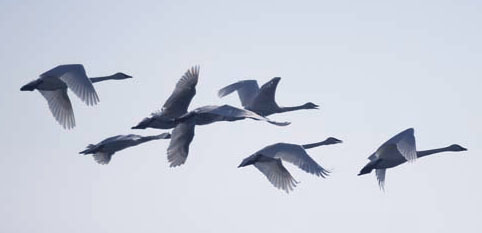![]()
![]()
viii. Goddess of the Swan

The Irish Brigid or Bridget, Scottish Bride, or Manx Bree, or Breeshey derive from a common root, a female deity who almost certainly served as the tutelary goddess for the first Iron Age peoples to enter Britain in the first millennium BC. Her cult lingered through until Romano-British times, most obviously as the divine patron of the Brigantes, the powerful northern tribe famously led at the time of the Roman conquest by the warrior queen Cartamandua.
With the arrival of Christianity Brigid became a saint, celebrated as Jesus's nursemaid, and sometimes even as his mother under the name 'Mary of the Gaels'. St Bride, or Bridget, bore an assortment of animal forms, but by far the most significant is that of the white swan. In her role as patron of childbirth, Bride-Bridget was associated with the Milky Way, where the celestial swan flies, and her mark was the bird's foot, anticipated by peoples of the Scottish Western Isles in their hearth on the morning of her feast day. This same symbol was associated by Welsh bards and druids with the goddess Minerva, the given to the Gallic form of Brigantia, or Brigid, by the Romans. Yet what might any of this have to do with Avebury's cult of the dead?
| A more direct association between swans and the northerly transmigration of the soul comes in the knowledge that in the Scottish Western Isles people saw whooper swans (and also greylag geese) migrating northwards to their breeding grounds in Iceland each spring as carrying the souls of the dead to heaven, which lay 'north beyond the north wind', an expression borrowed from classical mythology. Should a person be alive when the birds depart, then they would be free from death for another year. Cygnus being essentially circumpolar in Scotland would always have been seen in the northern night sky. Is this how the stars of Cygnus became associated with the swan, and why the bird was linked with not only the cosmic axis, but also the journey of the soul into the afterlife - because it was seen to fly towards the celestial pole? If so, then this connection can only have begun when Deneb occupied the position of Pole Star in c. 15,000 BC. |
Swans in flight. |
Among the peoples of the Baltic the swan replaced the stork as the bringer of new-born babies, showing that it both brought life and took it away again. This process of giving and taking life is exemplified at Çatal Huyuk in Southern-central Turkey where Neolithic wall sculptures contain vulture's skulls inserted horizontally so that the tips become the nipples of sculpted breasts, while murals nearby show human foetuses inside the bodies of vultures.
The cult of Bride-Bridget exemplified these archaic beliefs, and these survived through until the nineteenth century in the Scottish Western Isles. However, evidence of her worship in England has been scant until now. Yet archaeologists working in South-west England have recently unearthed macabre evidence of a pagan cult of the swan, possibly associated with the goddess Bride-Bridget, which survived through until the 1640s. It comes in the form of a series of earthen pits unearthed at Saveock, Cornwall, and found to contain carcasses of swans, as well as other votive offerings such as eggs, down feathers, crystals and stones. It is important to recall that at this time England was under Puritan rule, with the punishment for any kind of sympathetic folk magic being very severe indeed.
In Britain, the cult of the swan is likely to have come under the protection of Bride, whose feast day, 1st February, marked the northern departure of the migrating swans. Yet her worship proved to be only half the story, for a whole different cult of the swan once surrounded the return of the birds each November, a fact echoed in an archaic ceremony that continues each year on the River Thames.
![]()
![]()
